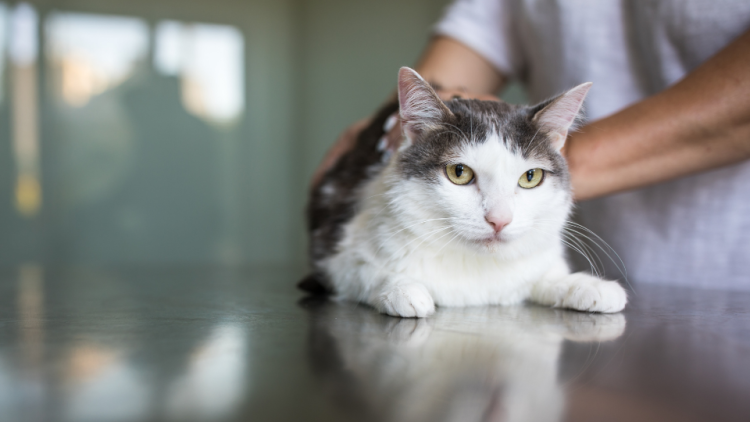Tapeworms are intestinal parasites that can make your cat very sick. But while these worms are unpleasant, they're also treatable, especially if you catch them in the early stages.
So, what are the symptoms, and how will you know if your cat has a tapeworm infection? This article will cover everything you need to know about this parasite and the illness it causes in cats.
Table of Contents:
- What are tapeworms?
- How do cats get tapeworms?
- Who's at risk of tapeworm infection?
- What are the symptoms of tapeworms in cats?
- How are tapeworms diagnosed?
- How to treat tapeworms in cats
- How to prevent tapeworms in cats
- Key Takeaways
Pro Tip: All pet insurance policies generally cover kittens as young as eight weeks old. By enrolling your cat at a young, healthy age, the insurance policy can cover treatment costs for conditions like tapeworm infection.
What are tapeworms?
Tapeworms are common parasites that live in a cat's intestines. Several types of tapeworm are known to infect animals, but the most common tapeworm in cats is Dipylidium caninum.
Tapeworms are among the few types of worms that you can see with the naked eye. They're flat, long worms with varying lengths (adult tapeworm can measure anywhere from six to 23 inches). These worms have a segmented body and a head with hooks and suckers. Once tapeworms start growing, the segments (called proglottids) fill with eggs and separate from the body, looking like grains of rice that pass through stool.
How do cats get tapeworms?
Unlike other intestinal parasites (such as hookworms and roundworms), cats cannot get tapeworm infection by eating the eggs. The worms must first pass through an intermediate host before they can infect the cat.

Cats get tapeworms by eating infected small animals like mice or infected fleas. Flea larvae eat the tapeworm eggs, which then develop as the larvae mature into adult fleas. If the infected flea lands on a cat and the cat consumes it (for instance, during grooming), the cat will also become infected. Once the cat ingests the flea, the tapeworm egg is released unharmed inside the cat's intestine. It hatches and then attaches itself to the intestinal lining, completing its lifecycle.
Who is at risk of tapeworm infection?
Tapeworms are more common in environments that are heavily infested with fleas, increasing the risk of infection in dogs and cats of all breeds, ages, and sex.
It's rare, but people can also become infected with Dipylidium caninum tapeworms by eating a contaminated flea. Small children are more at risk as they are less concerned with hygiene than adults.
Another less common group of tapeworms called Echinococcus poses a more significant threat to human health because it can cause a rare but potentially fatal disease. An Echinococcus infection is harder to diagnose than Dipylidium because the segments are small and invisible to the naked eye. Symptoms of the disease, called hydatidosis or hydatid disease, may not show for years but leads to the formation of cysts in the liver.
What are the symptoms of tapeworms in cats?
Very often, cats with tapeworms won't show any clinical signs. The most common symptom is tapeworm segments present in the cat's feces or around their anus.
If your feline friend constantly licks, scratches, or bites their rear end, they might have tapeworms. Your cat might also drag their hind legs across the floor in an attempt to scratch the area, but this is more commonly seen in dogs.
When tapeworms are present in large numbers, they can lead to weight loss, even if your pet's appetite remains unchanged. Cats with tapeworms will also have a shabby and dull coat, and some might experience diarrhea and vomiting. In some cases, a tapeworm will migrate to the cat's stomach, causing the animal to vomit a worm.
If you notice any of these symptoms, be sure to have your pet examined by a vet. Although tapeworms are not particularly harmful to cats, you should still take them seriously. If left untreated, tapeworms can cause intestinal inflammation and secondary health issues.
Older cats and kittens are especially susceptible to the adverse effects of intestinal parasites. In extreme cases, kittens may develop intestinal obstructions from adult tapeworms. Senior cats might develop inflammation in their gastrointestinal tract, resulting in chronic vomiting and loss of weight.
Fortunately, tapeworms are easy to treat if they're detected early.

How are tapeworms diagnosed?
A vet must diagnose a cat with tapeworms, usually after the owner detects the parasite around their pet's anus or in their feces. Unlike other parasites, fecal float tests aren't as helpful in the detection of tapeworm infection.
In some cases, a tapeworm diagnosis can be difficult because cats are fastidious groomers. They may clean the grain-like segments from their rear end or bury their poop in the litterbox before anyone can notice the evidence of infection.
How to treat tapeworms in cats
Treatment for tapeworms is a simple process that requires deworming medication administered orally or by injection. After treatment, the tapeworms usually dissolve in the intestines, so you will no longer see segments in the affected cat's feces.
New tapeworm medications and flea preventives are safe, effective, and cause very few or no side effects. The prognosis for successful treatment is excellent, but in flea-infested environments, the infection might become re-established within several weeks. Effective flea control is also required to clear the infection.
Your vet can provide the best advice on the deworming medication most suitable to treat your cat's tapeworm infection.
Pro Tip: Cat insurance can cover the cost of diagnostic testing, prescription medication, annual veterinary exams, and more with optional wellness plans that offset expenses for routine care, including flea prevention. Compare pet insurance plans to find the right coverage for your needs with flexible options you can customize.
How to prevent tapeworms in cats
When it comes to preventing tapeworms in cats, flea control is crucial. All cats, young and adult, should be on flea prevention monthly unless using a product that lasts longer than one month. Ask your vet which flea and tick prevention products they recommend for your specific cat.
If your cat is recovering from a flea infestation, extra precautions may be necessary. Wash all of the cat's bedding and toys in hot water, and sanitize the litter box daily. Be sure to dispose of your cat's feces properly and teach your children safe hygiene practices after playing outside.
If you have a little hunter or huntress on your hands, it's a good idea to try to stop your cat from chasing mice and other small animals that could be intermediate hosts. Cats who love chasing prey should see the vet regularly, regardless of whether they're showing any symptoms of tapeworms. Make an appointment for intestinal parasite testing and deworming once every three months.
Key Takeaways
- Tapeworms are long, flat, segmented worms that live in the cat's small intestines. The most common type of tapeworm affecting cats is Dipylidium, which uses a flea as an intermediate host to get into your pet.
- The most common symptom of tapeworms in cats is the presence of tapeworm in animals' poop or on their rear end. Cats infected with a large number of parasites could experience diarrhea, vomiting, and itchiness around the backside.
- If you notice any of the above-listed symptoms, take your cat to the vet as soon as possible because it's much easier to treat tapeworms in cats with early detection.
- The best way to prevent your feline companion from getting tapeworms is to keep them on a year-round flea preventative.
